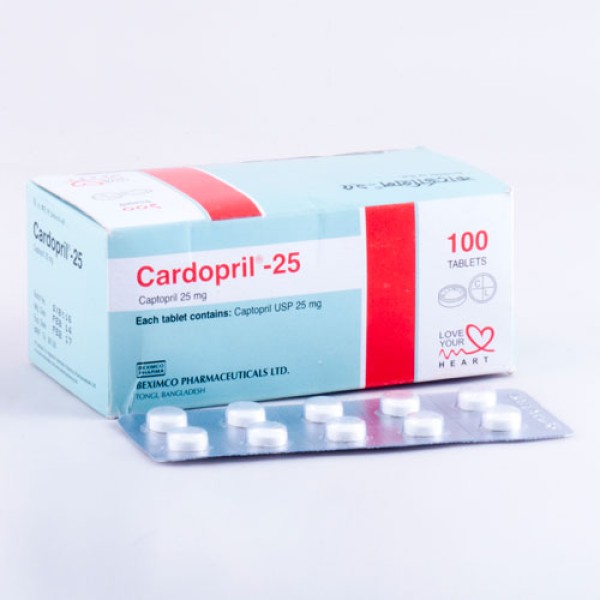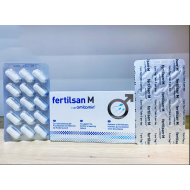
- Stock: In Stock
- Brand: Beximco Pharmaceutical
- Product ID: Captopril
100% Secure Payment

Cardopril 25
1. What is and what it is used for?
Cardopril (Captopril) is the first of a new class of antihypertensive agents a highly specific inhibitor of angiotensin converting enzyme. It is also effective in the management of heart failure. Cardopril is designated chemically as (1-[(2S)-3 Mercapto-2 methyl propionyl-L-proline.) Cardopril is available in potencies of 25 mg & 50 mg as scored tablet for oral administration. Cardopril inhibits angiotenin converting enzyme (ACE) involved in the conversion of angiotensin I to angiotensin II and may also reduce the degradation of bradykinin. Cardopril produces a reduction in total peripheral resistance and in patients with congestive heart failure & reduction in both preload and post load. Following oral administration, Cardopril produces a maximal effect within 1 to 2 hours, although the full effect may not develop for several weeks during chronic dosing. The duration of action is dose dependent and may persist for 6 to 12 hours.
Cardopril is used for mild to moderate hypertension as an adjunct to thiazide therapy in patients who have not responded effectively to thiazide treatment alone. Severe hypertension where standard therapy has failed. Cardopril is effective alone and in combination with other antihypertensive agents especially thiazide type diuretics. The blood pressure lowering effect of Cardopril and thiazides are approximately additive. It is also used as an adjunct to the treatment of severe congestive heart failure.
2. Before you take Cardopril®
Do not take this medicine and tell your doctor if:
A history of previous hypersensitivity to Captopril is present. Do not take this medicine if the above applies to you. If you are not sure, talk to your doctor before taking Cardopril.
Take special care with Cardopril
Cardopril should be used with great caution in patients with impaired renal function particularly if reno vascular disease is present or suspected and in patients with collagen vascular disorders such as systemic lupus erythematosus or scleroderma. Renal function should be assessed in all patients prior to administration of Cardopril. Patients with existing renal diseases or taking high doses of Captopril should be monitored regularly for proteinuria. Regular white blood cell counts should be made during the initial stage of therapy particularly in patients with collagen vascular disorders or impaired renal function and in patients receiving immunosuppressive therapy. Cardopril should not be used in patients with aortic stenosis or outflow tract obstruction. Patients with congestive heart failure and patients who are likely to be salt or water depleted due to concomitant treatment with diuretics or dialysis may experience symptomatic hypertension during the initial stages of Cardopril therapy, this may be minimized by starting with a low dose, preferably on retiring.
Taking other medicines
Diuretics potentiate the antihypertensive effectiveness of Cardopril. Potassium scanning diuretics (triameterene, amiloride and spironolactone) or potassium supplements may cause significant increase in serum potassium. Cardopril has been reported to act synergistically with peripheral vasodilators such as minimal. Concomitant therapy with indomethacin and possibly other nonsteroidal anti-inflammatory drugs may reduce the antihypertensive effect of Cardopril. Caution should be exercised in prescribing Cardopril for patients receiving concomitant therapy with immunosuppressant, procainamide alopurinal and other drugs known to cause neutropenia especially in patients with impaired renal function.
Pregnancy and breast-feeding
There are no adequate and well controlled studies in pregnant women. Cardopril should be used during pregnancy or for patient likely to become pregnant only if the potential benefit justifies a potential risk to the fetus. Cardopril is excreted in breast milk & should not be used in nursing mothers.
3. How to take Cardopril®?
Rapid absorption occurs after administration of therapeutic dose of Cardopril & peak blood level is achieved at about one hour. Presence of food in gastrointestinal tract reduces absorption by 30-40 percent. Cardopril therefore SHOULD BE GIVEN ONE HOUR BEFORE MEALS.
Hypertension: Treatment with Cardopril should be at the lowest effective dose, which should be titrated according to the need of the patients.
Mild to moderate hypertension: In mild to moderate hypertension, Captopril therapy should be used as an adjunct to thiazide therapy. Starting dose is 12.5 mg twice daily. The usual maintenance dose is 25 mg twice daily, which can be increased incrementally, at 2-4 weeks intervals, until a satisfactory response is achieved to a maximum of 50 mg twice daily.
Severe hypertension: Starting dose is 12.5 mg twice daily and can be increased incrementally to a maximum of 50 mg thrice daily.
Cardopril should be used together with other antihypertensive agent but the dose of those should be individually titrated.
A daily dose of 150 mg of Captopril should not normally be exceeded.
Heart failure: In congestive heart failure, an initial dose of 6.25 mg to 12.5 mg is given under close medical supervision.
The usual maintenance dose is 25 mg three times daily and should not exceed 50 mg thrice daily.
Increase in dosage should be delayed for at least two weeks to determine if a satisfactory response has occurred.
Cardopril should be used in conjunction with a diuretic and where appropriate digitalis.
If you take more Cardopril® than you should
In the event of overdosage blood pressure should be monitored and if hypotension develops volume expansion is the treatment of choice. Cardopril is removed by dialysis.
If you forget to take Cardopril®
If you forget to take a dose, take it as soon as you remember it. However, if it is nearly time for the next dose, skip the missed dose. Do not take a double dose to make up for a forgotten dose.
If you stop taking Cardopril®
Do not stop taking this medicine without talking to your doctor. You should not stop taking Cardopril just because you feel better. This is because the problem may come back or get worse again.
If you have any further questions on the use of this product, ask your doctor or pharmacist.
4. Possible side effects
Like all medicines, Cardopril can cause side effects, although not everybody gets them.
Haematological: Neutropenia anaermia & thrombocytopenia. Renal: Proteinuria elevated blood urea and creatinine, elevated serum potassium and acidosis.
Skin: Rashes, usually pruritic may occur. They are usually mild, transient and moculopapular, rarely urticarial in a few cases, the rash has been associated with fever and some patients have developed angio-neurotic oedema.
Pruritus, flushing vascular rash and photosensitivity have been reported.
Tell your doctor if any of the side effects gets serious or lasts longer than a few days, or if you notice any side effects not listed in this leaflet
5. How to store Cardopril®?
Keep in cool dry place. Keep out of the reach of children.














%20Pvt.%20Ltd./Movicol-Oral-Powder-190x190.jpg)
